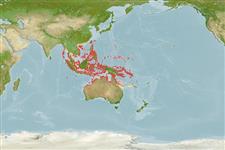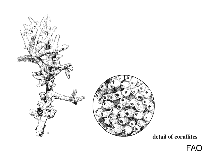Acropora kimbeensis Wallace, 1999
Pink-tip Acropora| Native range | All suitable habitat | Point map | Year 2050 |

|
| This map was computer-generated and has not yet been reviewed. |
| Acropora kimbeensis AquaMaps Data sources: GBIF OBIS |
Upload your photos
Google image | No image available for this species;
drawing shows typical species in Acroporidae.
Google image | No image available for this species;
drawing shows typical species in Acroporidae.
Classification / Names Common names | Synonyms | CoL | ITIS | WoRMS
Anthozoa | Scleractinia | Acroporidae
Environment: milieu / climate zone / depth range / distribution range Ecology
Reef-associated; depth range 3 - 12 m (Ref. 86439). Tropical; 25°N - 25°S, 92°E - 163°E
Distribution Countries | FAO areas | Ecosystems | Occurrences | Introductions
Indo-West Pacific.
Length at first maturity / Size / Weight / Age
Maturity: Lm ? range ? - ? cm
Found subtidally on patch reefs (Ref. 86439) and upper reef slopes, lagoons (Ref. 846). Also on submerged reefs (Ref. 98471).
Life cycle and mating behavior Maturity | Reproduction | Spawning | Eggs | Fecundity | Larvae
Members of the class Anthozoa are either gonochoric or hermaphroditic. Mature gametes are shed into the coelenteron and spawned through the mouth. Life cycle: The zygote develops into a planktonic planula larva. Metamorphosis begins with early morphogenesis of tentacles, septa and pharynx before larval settlement on the aboral end.
Main reference
References | Coordinator | Collaborators
Wallace, C.C. 1999. (Ref. 86439)
IUCN Red List Status (Ref. 130435)
Vulnerable (VU) (A4cde); Date assessed: 01 January 2008
CITES status (Ref. 108899)
Appendix II: International trade monitored
CMS (Ref. 116361)
Not Evaluated
Threat to humans
Human uses
| FishSource |
Tools
More information
Internet sources
BHL | BOLD Systems | CISTI | DiscoverLife | FAO(Publication : search) | Fishipedia | GenBank (genome, nucleotide) | GloBI | Gomexsi | Google Books | Google Scholar | Google | PubMed | Hexacorallians of the World | Tree of Life | Wikipedia (Go, Search) | Zoological Record
Estimates based on models
Preferred temperature
(Ref. 115969): 26.5 - 29.3, mean 28.7 (based on 1733 cells).
Price category
(Ref. 80766):
Unknown.



